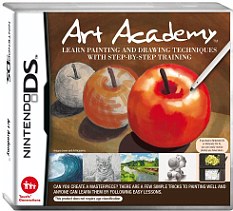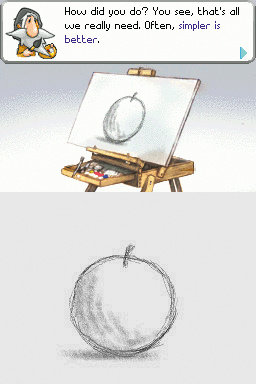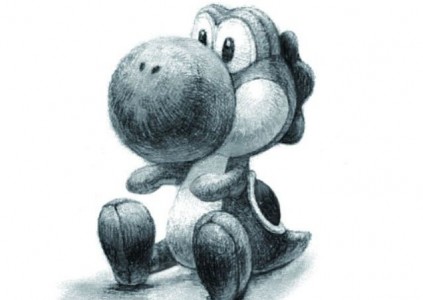Art Academy
Genre: Art Simulation
Platform: DS
Developer: Headstrong Games
Publisher: Nintendo
Released: Out Now
Now, for anyone who has had a go on Pictochat, Flipnote Studio, or for that matter, any of the other software out that involves using the stylus to draw or write: your sceptic feelings are completely justified. I too was highly sceptical when considering whether an art sim could work on the Nintendo DS. With no sensors measuring how hard you are pushing the stylus down on the touch screen, how could the DS possibly formulate a line corresponding to the strength you pressed down? If it couldn’t convey the exact mark you were trying to make, getting the boldness or consistency you were aiming for wrong, how could you even contemplate creating pieces of art? Mark making is essential for artists, and the sharpness of a line can completely transform a piece, which is why it was crucial for Nintendo to get Art Academy right.
Thankfully, they did, and after only the first lesson I had been convinced that the art sim could work. This is down to the large range of resources and materials at your disposal. In contrast to the ’one size fits all’ clumsy stylus markings of other games and applications which have only one setting; bold, Art Academy has you building up lines from smaller, faded lines. This approach of slowly building up from small lines which add up to form a stronger line is supported by the choice of three pencil types you are given: 2B, HB and 2H. Anyone who’s tried some art for themselves will probably already know the difference between these types of pencil, but for those who don’t the arrangement of numbers and letters indicates how soft it is. 2B is a very soft pencil, making it ideal for shading or adding delicate lines and details. The scale then moves on with HB being slightly harder and 2H being the hardest. With the hardest graphite, 2H offers artistically hard and sharp lines, but also quite light ones which means it’s useful for shaping up a framework for a painting, whereas HB is, to put it simply, the safe medium.
The differentiation between pencil types is just the tip of the iceberg, as other clever features help you to overcome the drawbacks of the touch screen technology. Such as the problem of the DS being unable to pick up whether or not you are holding the ‘pencil’ at an angle, a techniques popular among artists that is mainly used for shading. This problem is cunningly solved through a straight-forward pop-up menu, the same one you use to select a pencil, which presents you with a choice drawing with the ‘point’ or with the ‘flat’.
And it’s like this throughout the game. Every time the game is met by a hurdle which makes you wonder how the game will handle it with realism, it bounds over the hurdle gracefully. For instance, paint, a hard substance to master use of in real life at the best of times, behaves realistically from when you mix it in the virtual pallet, to when you apply it to your piece. If anything, it’s been simplified down a tiny bit just because paint is such a hard medium to use -by no means a bad thing. In fact, by making the paint a little less challenging to use, the developers have made the game more accessible and easier to learn from, as opposed to it’s real life counterpart in which no matter what colour you are aiming for, it will always end up brown.
The game is made up of two modes, and both of which possess relatively simple concepts. The first of which is Lessons Mode, which as the name suggests teaches you how to draw and paint using the software, but at the same time educating you on the skills and techniques that can be applied when doing art for real, outside of the game. Although there are no specific instructions beckoning you into the classroom and your mentor Vince, even if you are Wassily Kandinsky himself it’s highly recommended you visit this section before the other mode. Even if you know what you are doing art-wise, it’s still worth a look if only just to come to terms with the software before you move onto the next mode, Free Paint Mode. Again, it’s name is a large giveaway and subsequently, this mode is fairly self-explanatory. Basically, you have a blank piece of paper and are given free reign to sketch or paint whatever you like.
But first, Lessons Mode, a key part of the game where the ‘step-by-step’ training is delivered. You are guided by your teacher, Vince, hardly and arty name, though it is probably meant to have some link with the legendary Vincent Van Gogh, it’s just a shame it couldn’t be something more arty. How does Pierre sound? Anyway, we’ll forgive them because the lessons are present in a basic and linear style, with easy instructions and a tidy control scheme/menu system. It truly is step-by step with Vince taking you through each stage, teaching you not only the game mechanics but techniques applicable to the real thing. He also shows you each and every process by doing each one for himself for you to see, before you give it a go for yourself. The Lessons Mode spans over 10 separate lessons, with each one telling you something new. The save system compliments the lesson structure too, with save points offered midway through lessons, as well as the ability to save manually if you need to stop in the middle of a lesson. While these 10 lessons will fly by, you will learn a lot from them, both about the software and art in general, so in this respect, playing through Lessons Mode is a positive use of time.
However, it is in Free Paint Mode, with the shackles off, that some of the games great added extras begin to shine. Like using the top screen to display a reference picture, a brilliant move by the developers which makes full use of the DS’s dual screen interface. Simply scroll through the game’s image gallery, select a reference image and voila! It appears on the top screen for you to examine as you see fit. But not content with solving both lack of inspiration and lack of a willing subject, two problems artists have been known to regularly suffer from, the developers have included even more bonus features, particularly for DSi owners. Utilising the DSi’s camera, the game lets you take your own photographs and store the scene for future reference when sketching. Combined with how small and portable the DS is, it makes for a great artist’s tool. Not only could you carry it with you and use it to sketch the scene unveiling before your eyes, but if you didn’t have this duration of time to divulge into drawing at that point, you could snap a few pictures and come back to it later.
With everything taken into account, Art Academy is a decent game. While the nature of play won’t suit everyone, (with the game’s target audience being those interested in art), it’s a fairly good bundle and almost two things in one: a software application and an art guide. The game is subtly educational , but not to the point where it feels like a chore, teaching you how to use the software, and at the same time expanding your knowledge of mixed media and how to use it, as well as vital techniques and skills used in the art world. It may not constitute doe an expansive art guide, and learning about art on the game should probably be supplemented by a more detailed art guide if you’re serious about picking up art, but for a videogame it’s pretty darn good for learning how to do art. Plus, seeing the masterpieces on the box art should be motivation enough to buy this game and develop a mastery of it. The works of art that this game is capable of creating in the right hands are breath-taking.

Pros
- Simple step-by-step training which helpd you to develop knowledge applicable to real world art
- Well thought-out controls
- Capitalises on the DS/DSi’s features
- Free Paint Mode provides an art studio for endless hours of entertainment
Cons
- The nature of the game means it’s not for everyone
- Squeezing your hands around a tiny screen trying to do art
- Advanced software means Lessons Mode is a must- no pick up and play value
- Can be text-heavy at times




